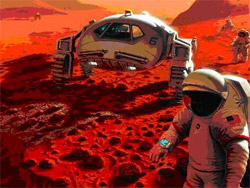'Globe' from the school during the conquest of Mars
Scientists believe that they have found a way to protect astronauts from dangerous radiation rays in space, which is one of the barriers to bringing people to Mars.
This device was developed by British and Portuguese scientists and has been published on Plasma Physics and Controlled Fusion.
Radiation in space is one of the biggest challenges for the British and European Union's project to bring people to Mars in the first half of this century.
A journey of at least 18 months and during this time astronauts must be exposed to even smaller elements that are constantly moving in space. These particles have the ability to shred DNA and increase the risk of cancer and other disorders.

Radiation in space is a major challenge for trips to Mars (Source: NASA)
The danger from this radiation has been known for a long time but there seems to be no effective solution due to economic difficulties as well as technical level.
Some experts even suggested using lead or giant water containers to protect astronauts. However, the cost to bring these things from the ground to the operating trajectory is too high.
Another idea is to use a magnetic shield model as the Earth's magnetic shield. The main task of this shield is to deflect dangerous cosmic rays.
Based on previous calculations, the spacecraft must have a device to create a magnetic shield with hundreds of kilometers of circumference to ensure safety.
However, such a device is too bulky and needs a huge amount of energy. The magnetic field shield is too strong because this device can even cause harmful effects to the crew.
Protection ball
British and Portuguese scientists studied the idea again and found no need to create such a giant magnetic shield. They claim that just creating a 'magnetic sphere' with a diameter of several hundred meters around the spacecraft is enough.
'This idea is exactly the same as the science fiction movie Star Trek, when Scottie activates the shield to protect the Enterprise spacecraft from the proton beams,' Bob Bingham, home The study belongs to Rutherford Appleton test center in the UK, said.
Their studies use a digital model in which extremely hot plasma will be retained by a magnetic shield. This model is also used by experts in nuclear fusion (nuclear fusion).
This technology provides an accurate view of the reaction of individual elements as they collide with a two-pole magnetic shield.
Thus, researchers can create shield models from smaller and safer fields.
Experiment
Researchers used a plasma lab at a high-tech institute in Lisbon to test the device's microcosm in terms of an artificial solar storm.
For the journey to Mars, this protective device will weigh a few hundred kilograms and consume only one third of the energy of a normal communications satellite.
The magnetic force of this device created is exactly the same as the Earth's magnetic force, which minimizes the dangers that astronauts face in space.
In 2001, a NASA study showed that there were at least 39 astronauts suffering from cataract after flying into space, 36 of them had ever stepped out of Earth's orbit.
The study also said that the risk of cancer death for a 40-year-old and non-smoker will increase to 40% after the trip to Mars, twice as high as on the ground.
- Water can exist just below the surface of Mars
- Find evidence of groundwater around Mars?
- Mars comes closest to the globe on weekends
- Try food on Mars
- Discover Mars-3 on Mars
- Did the ocean on Mars get into the rock?
- School for British nobility: Being like a fairy but suffering is more than a normal school
- 10 individuals received the 2013 Golden Globe Award
- NASA explains the confusing
- Found life on Mars?
- Top 10 photos of Mars
- Life may have existed 700 million years on Mars
 Van Allen's belt and evidence that the Apollo 11 mission to the Moon was myth
Van Allen's belt and evidence that the Apollo 11 mission to the Moon was myth The levels of civilization in the universe (Kardashev scale)
The levels of civilization in the universe (Kardashev scale) Today Mars, the sun and the Earth are aligned
Today Mars, the sun and the Earth are aligned The Amazon owner announced a secret plan to build a space base for thousands of people
The Amazon owner announced a secret plan to build a space base for thousands of people